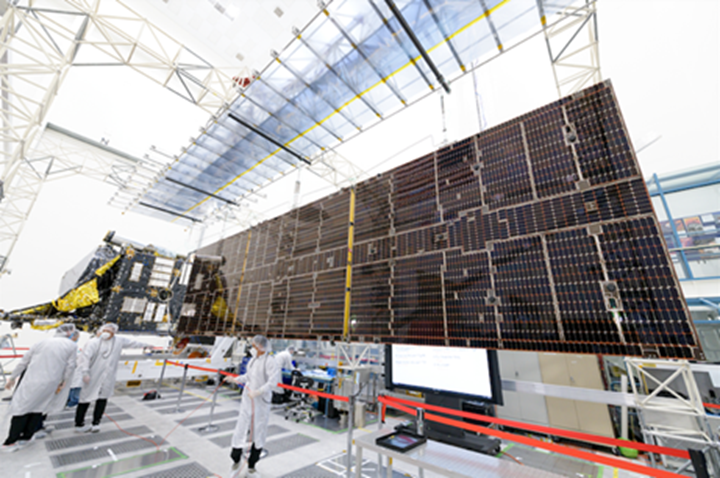As humanity expands its reach throughout the solar system, Maxar continues to invest in new technologies and innovation that will drive us forward. At the beginning of the space race of the 1960s, Maxar was a commercial partner on the pioneering Apollo program, and now has been building reliable spacecraft for more than six decades. Our partnership with NASA runs deep, and we continue to progress on three missions that will advance humanity’s study of the universe.
Maxar’s Robert Curbeam, SVP Space Capture and former NASA astronaut, talks about how Maxar is contributing to the future of space exploration, and humanity’s trajectory to Mars.
Psyche: Journey to a metal world
Maxar is collaborating with NASA Jet Propulsion Laboratory (JPL) and Arizona State University on the first mission to explore a metal-rich asteroid, rather than one of rock or ice. This mission will travel to the main asteroid belt to explore how our planet was formed.
“The Psyche project has been a successful collaboration between NASA, academia and industry, especially as we overcame the challenges of the global pandemic,” said Steve Scott, Maxar’s Senior Director of Program Management on the Psyche mission. “For more than a year, a Maxar Integration and Testing (I&T) team worked onsite at JPL to complete Flight System I&T operations. We successfully completed all of the environmental testing and were excited to see the Psyche spacecraft shipped to the Kennedy Space Center (KSC) in April 2022.”
Now that the Psyche spacecraft has arrived at KSC, its solar arrays will be re-integrated in preparation for launch. After launch, the spacecraft will move farther from the sun and deeper into the asteroid belt, requiring the solar panels to operate with progressively lower light to power the science instruments on board.

Psyche will travel 1.5 billion miles to reach a metal-rich asteroid. The solar arrays, shown above at JPL, will provide the power the spacecraft needs to make the long journey. Image Credits: NASA/JPL-Caltech
Power and Propulsion Element (PPE) for NASA’s Gateway
NASA’s Gateway, a vital component of the agency’s Artemis program and a government-industry collaboration, will serve as an orbiting outpost at the Moon, for both crewed and uncrewed missions. This small space station will provide essential support for long-term human return to the lunar surface and serves as a staging point for future deep space exploration. Maxar’s PPE is the foundational element for the Gateway, providing power, maneuvering, attitude control and communications systems.
After passing the preliminary design review process and several rounds of testing at NASA’s Glenn Research Center, PPE continues to progress toward launch in late 2024. The Habitation and Logistics Outpost (HALO) for Gateway, built by Northrop Grumman, will be integrated with PPE on the ground at NASA’s Kennedy Space Center before launch. Once launched, PPE will immediately begin propelling the spacecraft toward lunar orbit.
“Working in close partnership with our customer at NASA Glenn, key stakeholders in Gateway’s program office and Northrop Grumman, we have completed all preliminary design work on PPE,” said Vince Bilardo, Senior Executive Program Director for NASA programs at Maxar. “Together, this system will be the most powerful solar electric propulsion (SEP) spacecraft ever flown. Gateway will serve as an important jumping off point for missions to the lunar surface, opening the opportunity for us to test SEP technology for deep space exploration.”
The SEP system features the Maxar-built high-power control electronics, a Moog-provided xenon feed system, four Busek-built Hall effect thrusters and three Advanced Electric Propulsion System thrusters provided by Aerojet Rocketdyne.
Maxar teams are now finalizing all subsystem and system designs on the road to a final critical design review in early 2023.
The video above shows a PPE thruster firing test at NASA Glenn in April 2022. Maxar is building PPE for the lunar Gateway, which will serve as an orbiting outpost at the Moon.
Building a robotic arm for exploring the lunar surface
Maxar has a long history of providing robotic arms to NASA missions, including six landers and rovers currently on Mars. Maxar’s Sample Acquisition, Morphology Filtering and Probing of Lunar Regolith (SAMPLR) arm is one of 12 externally developed Lunar Surface Instrument and Technology Payloads (LSITP) that NASA selected for delivery to the Moon by its Commercial Lunar Payload Services (CLPS) initiative under the agency’s Artemis program to send the first woman and the first person of color to the Moon.
“We are excited to extend our long history of planetary robotics with the SAMPLR arm heading to the Moon to further planetary science,” said David Cardinale, Maxar’s Director of Program Management on the SAMPLR mission. “Qualifying our robotic system for lunar applications and providing the hosting capabilities for other payloads will allow for more science to be done on the Moon.”
With the robotic arm fully assembled, it is now ready for testing in a simulated lunar environment in preparation for Moon operations. Maxar plans to deliver the arm to Masten Space Systems, the lander provider, later this year, with launch to the lunar surface scheduled for 2023.

Maxar is building the SAMPLR arm, a robotic manipulator that will collect samples and determine the geotechnical properties of lunar regolith for additional study.
The challenges of space are well known to humanity. But, if we continue to work with our partners to build and test new technologies, we will be well equipped to meet those challenges. As NASA’s Artemis program begins a regular launch cadence in the next few years, there are exciting times ahead for humans to return to the Moon as a stepping stone to journey deeper in space and we believe robotics and SEP will be a key enabler for achieving these goals.
Journey into Deep Space
Maxar’s space capabilities will enable humans to reach beyond the Moon.
Explore with Maxar